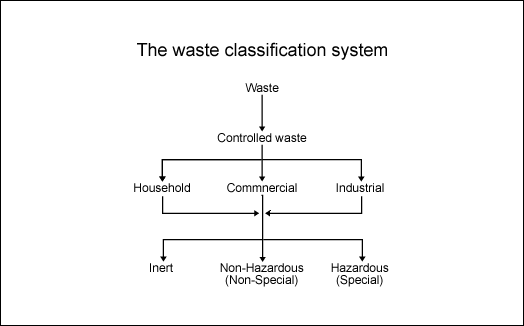Waste – Classification
Source: Environment Agency
Controlled Waste
Most wastes from commerce and industry are controlled wastes, including materials that are to be recycled. Controlled waste includes waste arising from domestic, industrial and commercial premises as well as Hazardous Waste for which there are additional regulations. Controlled Waste is also referred to as Directive Waste by the Waste Management Regulations 1994.
Waste is defined (following implementation of the 1991 EU Framework Directive on Waste) as “any substance or object in the categories set out in Schedule 2B of the Environment and Protection Act 1990, which the holder discards or intends to or is required to discard.” Schedule 2B includes the following:
- Production or consumption residues not otherwise specified below
- Off-specification products
- Products whose date for appropriate use has expired
- Materials spilled, lost or having undergone other mishap, including any materials, equipment, etc., contaminated as a result of mishap
- Materials contaminated or soiled as a result of planned actions (e.g. residues from cleaning operations, packing materials, containers, etc.)
- Unusable parts (e.g. reject batteries, exhausted catalysts, etc.)
- Substances which no longer perform satisfactorily (e.g. contaminated acids, contaminated solvents, etc.)
- Residues of industrial processes (e.g. slags)
- Residues from pollution abatement processes e.g. scrubber sludges, spent filters, etc.)
- Machining or finishing residues
- Residues from raw materials extraction and processing (e.g. mining residues, oil field slops, etc.)
- Adulterated materials (e.g. oils contaminated with PCBs, etc.)
- Any materials, substances or products whose use has been banned by law
- Products for which the holder has no further use (e.g. agricultural, household, office, commercial and shop discards etc.)
- Contaminated materials, substances or products resulting from remedial action with respect to land
- Any materials, substances or products which are not contained in the above
categories
Hazardous or Special Waste
Section 62 of the EPA empowers the Secretary of State to make regulations for the treatment, keeping or disposal of particularly dangerous or difficult wastes that have hazardous properties. This regime is managed under the Hazardous Waste (England and Wales) Regulations 2005. Such wastes include oily waste (e.g. oily rags, cuttings, etc., and well clean up fluids) and chemical wastes, and other hazardous substances such as asbestos. Radioactive wastes may also be defined as hazardous, although radioactivity in itself does not classify radioactive waste as hazardous.
For offshore waste disposal purposes, hazardous waste can be defined as any wastes which:
- Are or contains prescription medicines, or
- Have a flash point less than 55 degrees Celsius, or
- Contain any components deemed to be either an oxidant, toxic, corrosive, harmful, irritant, carcinogenic, infectious, teratogenic, mutagenic or ecotoxic.
Radioactive waste may be classed as Special Waste if it also has these properties. It is not classified as special waste simply on the basis of its radioactivity.
NB: In Scotland the regime for managing such dangerous or difficult wastes is the Special Waste Regulations 1996.

